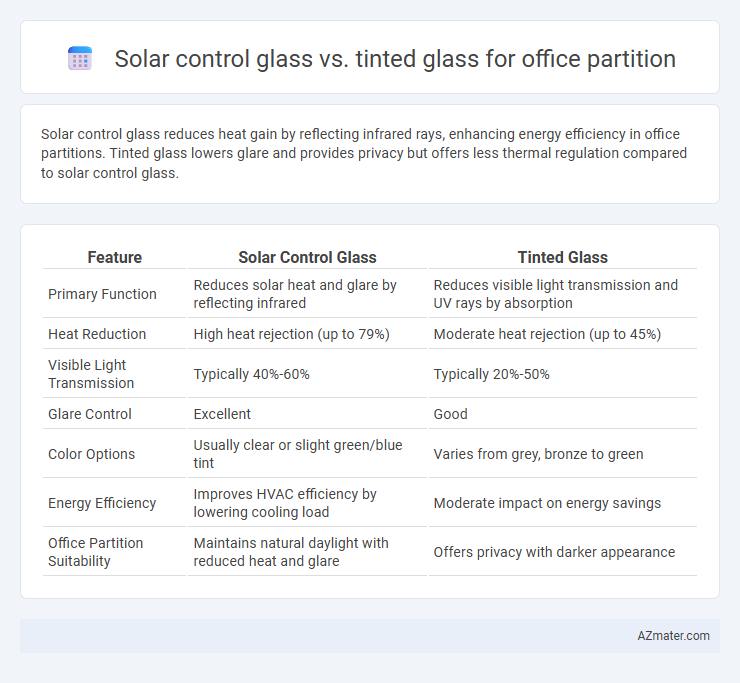Solar control glass reduces heat gain by reflecting infrared rays, enhancing energy efficiency in office partitions. Tinted glass lowers glare and provides privacy but offers less thermal regulation compared to solar control glass.
Table of Comparison
| Feature | Solar Control Glass | Tinted Glass |
|---|---|---|
| Primary Function | Reduces solar heat and glare by reflecting infrared | Reduces visible light transmission and UV rays by absorption |
| Heat Reduction | High heat rejection (up to 79%) | Moderate heat rejection (up to 45%) |
| Visible Light Transmission | Typically 40%-60% | Typically 20%-50% |
| Glare Control | Excellent | Good |
| Color Options | Usually clear or slight green/blue tint | Varies from grey, bronze to green |
| Energy Efficiency | Improves HVAC efficiency by lowering cooling load | Moderate impact on energy savings |
| Office Partition Suitability | Maintains natural daylight with reduced heat and glare | Offers privacy with darker appearance |
Introduction: Understanding Office Partition Glass Options
Solar control glass significantly reduces heat gain and glare while maintaining natural light, making it ideal for energy-efficient office partitions. Tinted glass primarily darkens the space to reduce brightness but offers less insulation against solar heat compared to solar control glass. Choosing solar control glass enhances workplace comfort and reduces HVAC costs by controlling solar radiation more effectively than tinted glass.
What is Solar Control Glass?
Solar control glass is specially designed to reduce solar heat gain while maintaining natural light, making it ideal for office partitions that require energy efficiency and comfort. It features a coating that reflects a significant portion of infrared and ultraviolet rays, helping to lower cooling costs and reduce glare without compromising visibility. Unlike tinted glass, which darkens the view and reduces light transmission, solar control glass preserves clarity while enhancing thermal insulation and occupant comfort.
What is Tinted Glass?
Tinted glass is a type of glass infused with colorants during manufacturing to reduce glare and limit visible light transmission, enhancing privacy and comfort in office partitions. It effectively blocks a portion of solar heat while maintaining clear views, making it an energy-efficient choice for workspace environments. Compared to solar control glass, tinted glass provides a natural shading effect without specialized coatings, balancing aesthetics and functionality in modern office design.
Key Differences Between Solar Control and Tinted Glass
Solar control glass features a special coating that reflects solar radiation, reducing heat gain and improving energy efficiency in office partitions. Tinted glass, by contrast, absorbs and reduces visible light and glare but does not significantly block infrared radiation, leading to less effective heat reduction. Solar control glass maintains clearer visibility while offering superior thermal insulation compared to the darker appearance and reduced light transmission of tinted glass.
Energy Efficiency: Which Glass Performs Better?
Solar control glass significantly outperforms tinted glass in energy efficiency for office partitions by selectively blocking heat-causing infrared rays while maximizing natural daylight transmission. Unlike tinted glass, which reduces heat by absorbing and darkening the solar spectrum but lowers visible light levels, solar control glass improves thermal comfort without compromising workspace illumination. This selective solar heat rejection reduces cooling loads and energy costs, making solar control glass the superior choice for energy-efficient office environments.
Light Transmission and Glare Reduction
Solar control glass for office partitions offers superior glare reduction by incorporating coatings that reflect infrared rays while maintaining high visible light transmission, typically ranging between 40% to 70%. Tinted glass reduces light transmission by adding colorants, often lowering visible light transmission below 50%, which can significantly darken the office space. For optimal balance between natural light and glare control, solar control glass is preferred due to its ability to maximize daylight use without compromising occupant comfort.
Privacy Levels: Solar Control vs Tinted Glass
Solar control glass offers enhanced privacy by reducing glare and limiting visibility through advanced coatings that deflect infrared and ultraviolet rays while maintaining natural light. Tinted glass provides moderate privacy by darkening the glass surface, which obscures vision but may reduce interior brightness and clarity. For office partitions, solar control glass is preferred for superior privacy without compromising daylight, whereas tinted glass serves better in settings prioritizing light dimming over complete visual separation.
Aesthetic Impact on Office Interiors
Solar control glass enhances office interiors by reducing glare and controlling heat without compromising natural light, maintaining a bright and professional ambiance. Tinted glass offers a sleek, uniform appearance that adds a modern, stylish touch but can darken spaces, potentially diminishing natural illumination. Choosing between the two depends on balancing aesthetic goals with functional needs for light management and energy efficiency in office partitions.
Cost Comparison and Return on Investment
Solar control glass typically costs 20-30% more than tinted glass due to its advanced coatings that reflect UV and infrared rays, reducing cooling expenses. Although the initial investment is higher, solar control glass offers better energy efficiency, often resulting in a 15-25% reduction in air conditioning costs, which accelerates return on investment within 3-5 years. Tinted glass has lower upfront costs but provides less thermal performance, potentially leading to higher long-term energy expenses and a slower ROI.
Choosing the Right Glass for Your Office Partition
Solar control glass enhances energy efficiency by reducing solar heat gain and glare, making it ideal for maintaining a comfortable office environment and lowering cooling costs. Tinted glass offers privacy and reduces visible light transmission but may compromise natural daylight and color accuracy, which can affect workspace ambiance. Selecting the right glass depends on balancing energy savings, visual comfort, and aesthetic requirements specific to your office partition needs.

Infographic: Solar control glass vs Tinted glass for Office partition
 azmater.com
azmater.com